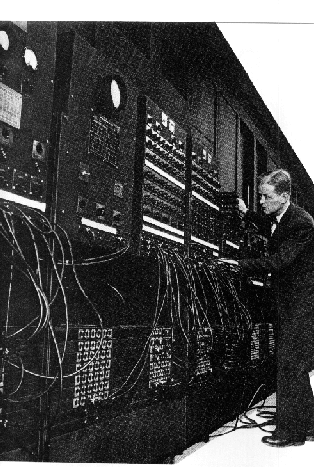HISTORY OF COMPUTER
The history of computer began long before the modern discipline of computer science that emerged in the 20th century, and was hinted at in the centuries prior. The progression, from mechanical inventions and mathematical theories towards modern computer concepts and machines, led to a major academic field and the basis of a massive worldwide industry.
The earliest known tool for use in computation was the abacus, developed in the period between 2700–2300 BCE in Sumer. The Sumerians' abacus consisted of a table of successive columns which delimited the successive orders of magnitude of their sexagesimal number system. Its original style of usage was by lines drawn in sand with pebbles . Abaci of a more modern design are still used as calculation tools today.
The Antikythera mechanism is believed to be the earliest known mechanical analogue computer. It was designed to calculate astronomical positions. It was discovered in 1901 in the Antikythera wreck off the Greek
island of Antikythera, between Kythera and Crete, and has been dated to
c. 100 BCE. Technological artifacts of similar complexity did not
reappear until the 14th century, when mechanical astronomical clocks appeared in Europe.
When John Napier discovered logarithms for computational purposes in the early 17th century, there followed a period of considerable progress by inventors and scientists in making calculating tools. In 1623 Wilhelm Schickard
designed a calculating machine, but abandoned the project, when the
prototype he had started building was destroyed by a fire in 1624 . Around 1640, Blaise Pascal, a leading French mathematician, constructed a mechanical adding device based on a design described by Greek mathematician Hero of Alexandria. Then in 1672 Gottfried Wilhelm Leibniz invented the Stepped Reckoner which he completed in 1694.
In 1837 Charles Babbage first described his Analytical Engine
which is accepted as the first design for a modern computer. The
analytical engine had expandable memory, an arithmetic unit, and logic
processing capabilities able to interpret a programming language with
loops and conditional branching. Although never built, the design has
been studied extensively and is understood to be Turing equivalent.
The analytical engine would have had a memory capacity of less than 1
kilobyte of memory and a clock speed of less than 10 Hertz .
FIRST COMPUTERS
 The executable instructions composing a program were embodied in the separate
units of ENIAC, which were plugged together to form a route through the
machine for the flow of computations. These connections had to be redone for
each different problem, together with presetting function tables and switches.
This "wire-your-own" instruction technique was inconvenient, and only with
some license could ENIAC be considered programmable; it was, however,
efficient in handling the particular programs for which it had been designed.
ENIAC is generally acknowledged to be the first successful high-speed
electronic digital computer (EDC) and was productively used from 1946 to 1955.
A controversy developed in 1971, however, over the patentability of ENIAC's
basic digital concepts, the claim being made that another U.S. physicist, John
V. Atanasoff, had already used the same ideas in a simpler vacuum-tube device
he built in the 1930s while at Iowa State College. In 1973, the court found in
favor of the company using Atanasoff claim and Atanasoff received the
acclaim he rightly deserved.
The executable instructions composing a program were embodied in the separate
units of ENIAC, which were plugged together to form a route through the
machine for the flow of computations. These connections had to be redone for
each different problem, together with presetting function tables and switches.
This "wire-your-own" instruction technique was inconvenient, and only with
some license could ENIAC be considered programmable; it was, however,
efficient in handling the particular programs for which it had been designed.
ENIAC is generally acknowledged to be the first successful high-speed
electronic digital computer (EDC) and was productively used from 1946 to 1955.
A controversy developed in 1971, however, over the patentability of ENIAC's
basic digital concepts, the claim being made that another U.S. physicist, John
V. Atanasoff, had already used the same ideas in a simpler vacuum-tube device
he built in the 1930s while at Iowa State College. In 1973, the court found in
favor of the company using Atanasoff claim and Atanasoff received the
acclaim he rightly deserved.
No comments:
Post a Comment